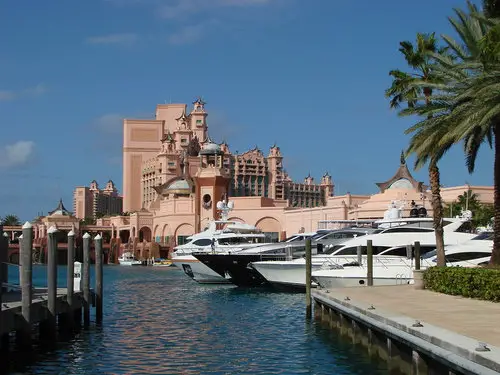Getting to & around Bahamas by boat
If you are a boater, then a trip to Bahamas by your own boat or yacht should be on top of your agenda. Because the Atlantic waters that you cross and the islands that you see from your own boat offer you unparalleled views and experience. The trip of course comes with some risks which if you plan and execute well can remain well under control, but the awards are awesome.
Boats at Atlantis Marina, Paradise Island, Bahamas
Photo: sergio_leenen, flickr, cc by-nd 2.0
Your risk is you will travel across an open ocean and be subjected to the strong northward current of the Gulf Stream. So you need to choose the right boat and be well equipped because weather conditions in this part of the Atlantic can change fast while storms and swells are common.
It's best to start from the east coast of south Florida like Miami, Fort Lauderdale or West Palm Beach. This is because the nearest islands of Bahamas like Bimini is only 50 miles east of Miami. This is the shortest distance between the USA and Bahamas. Another island close to the south Florida is Grand Bahama (Freeport is the main settlement here).
Rest of the Bahamas islands extend as far as 760 miles towards south east, and reaching any such island would require skills to navigate around other islands and passing through channels and cuts that are full of reefs and shoals. And note that navigational aids here around the Bahamas are very little to none.
Map showing Bahamas islands across Miami
Choosing the right boat
There was a time when many yachters would take their sail boats to Bahamas from the Florida. However these days you see modern motor boats most having center console operation and a small cabin in case one decides to anchor out instead of staying in a resort.
Depending on your requirement including number of crews, you can choose a boat less than 30ft or larger. But note that permit fee for boats larger than 35ft are double. These days the most common boats are 25-30ft. Whichever boat you choose, ensure that its well built and have enough capacity to carry all your equipment and supplies.
Another important consideration is the speed. Higher the speed, faster you can reach the destination and avoid possible bad weather conditions on the way. For example with a boat speed of about 25 nautical miles per hour, it takes about 2 hours to reach Bimini from Miami while with 10 nautical miles per hour, about 5 hours of sailing in good weather conditions.
Equipment and Supply
(Indicative)
Anchors are one of the most important things to consider. Depending on a fault on your boat or weather condition, you may need to anchor anywhere on the ocean or a harbor. You should carry minimum two different types of anchors (preferably Fortress and CQR anchors with hinged shank). This will ensure you can properly anchor on any type of bottom - soft or hard.
Carry food and drinking water to sustain minimum a week although you may anchor at marinas and refill your stock. This is to take care of any adverse situation where you might be stuck on the ocean for days without help reaching you.
Get EPIRB (Emergency Position Indicating Radio Beacon) installed in the boat preferably with built-in GPS to help locate the boat accurately during emergency. You can also rent an EPIRB.
Carry proper life jackets for all in the boat.
Good quality GPS Chart Plotter which can accurately plot location of the boat which is essential for the navigation. Note the channels between the islands are often unmarked and practically have no navigational aids... it would require good navigational skill to negotiate these channels that are full of reefs and sandy shoals.
Get a manual chart and keep plotting your location manually. This will serve as the backup for GPS chart plotter should it fail.
Carry both portable and mounted VHF radios so that you can communicate with other boats and on-shore radio stations for any help. However it may be out of range in several places. Also carry satellite phones as back up (which you can rent too). You will get wi-fi connections in several marinas in Bahamas, but they may not always work quite effectively.
Take enough spares particularly for the critical components as well as engine oil, fuel etc.
Ports of Entry
Here are the ports of entries in Bahamas by island:
The Abacos
Government Docks at Marsh Harbor and Sandy Point
Walker's Cay, Spanish Cay, Treasure Cay Marina
Andros
Government Docks at Fresh Creek, Mangrove Cay, Morgan's Bluff, and San Andros
Bimini/Cat Cay
Government Dock at Alice Town, Bimini
Cat Cay Club Marina
The Berry Islands
Great Harbour Cay Marina, Chub Cay Club Marina
Cat Island
Government Docks at Bennett's Harbor and Smith's Bay.
Eleuthera and Harbour Island
Government Docks at North Eleuthera, Harbor Island, Rock Sound, Spanish Wells
Cape Eleuthera Marina
The Exuma
Government Dock at Black Point
Staniel Cay
Grand Bahama Island
Bell Channel Marina, Port Lucaya Marina Village, Freeport Harbour, Sunrise Resort and Marina, Xanadu Marina, Old Bahama Bay Marina
Inagua
Government Dock at Matthew Town
Long Island
Flying Fish Marina, Stella Maris Marina
Mayaguana
Government Docks at Matthew Town
New Providence
Atlantis Marina, Bayshore Marina, Brown's Boat Basin, Clifton Pier, Coral Harbour Marina, East Bay Yacht Basin, Hurricane Hole Marina, John Alfred Dock, Kelly's Dock, Lyford Cay Marina, Nassau Harbour Dock West, Union Dock
San Salvador
Government Dock at Cockburn Town
Entry and Exit Requirements
While arriving at Bahamas by boat, all on the boat must go through Immigration and Customs clearance on the first port of arrival. All need to fill out a Customs Clearance form and an Immigration Card. Only the captain of the boat is allowed to leave the boat until the officers have inspected and cleared the boat. Any arms and ammunitions must be declared in full and kept locked.
While returning, remember you need to hand over your copy of your Immigration Card at the last port you visit in Bahamas at the time of departure.
An Entry Fee will be charged which will include sailing permit, fishing permit and departure tax. Entry fee for a boat up to 35ft is $150 and larger than 35ft is $300 (indicative). The fee covers three persons on the boat and additional person is charged $25 each.
US, UK and Canada citizens need to carry valid passport for entry into a Bahamian port. Other nationals may additionally need visa and other travel documents, and should contact the nearest Bahamas Embassy, Consulate or High Commission in their respective country for exact requirement.
On return while arriving at a US port, the captain of the vessel must immediately contact the US Customs and Border Protection (CBP) to notify the arrival. They will direct the boat to the nearest port of entry where all in the boat must present themselves with relevant documents for entry.
Visit the website www.cbp.gov for details on arrival at US port.
Marinas in Bahamas
There are numerous marinas all across the Bahamas, and most islands have more than one marinas. Although there are several full service marinas, some marinas have no service at all or would have been damaged by the last hurricane / storm or has been temporarily closed being hit by adverse economic conditions. Some of the functioning marinas would have potable water, in some you would have to buy drinking water. So do inquire with the marina staff before you go.
Go through
Marinas in Bahamas to get a list of marinas for each island in the Bahamas along with Marina contact information where you can call or email.
Sample Route
One of the very common routes for Boaters heading to Bahamas from south Florida is to start from Miami or Fort Lauderdale. The first port of entry would be at Bimini 50 miles east of Miami. You can then proceed further 80 miles south east to Chub Cay in Berry islands. The next destination is Nassau in New Providence island which is 40 miles south east of Chub Cay.
Next you need to carefully navigate through many reefs as you head towards south east and reach Exuma Cay (which is the Northern Exuma) in about 30 miles. You can find good moorings and anchorage here. From Exuma you head back to Florida.
Further Info
The Bahamas Ministry of Tourism
P.O. Box N-3701, Nassau, Bahamas
Phone: 242-302-2000; Toll Free: 1-800-Bahamas
|
 By Raj Bhattacharya By Raj Bhattacharya
Raj, a seasoned travel writer and Bermuda destination expert, has extensive global travel experience. This website reflects his profound insights, garnered over nearly two decades of dedicated findings and research on the island. Raj has assisted countless Bermuda-bound visitors by providing direct, personalized responses to their queries and imparting his wealth of knowledge through this platform. This site serves as an indispensable guide for those seeking informed and reliable insights into Bermuda's treasures.
|
Related Articles
|
Visitors' Reviews and Comments
|

 By Raj Bhattacharya
By Raj Bhattacharya